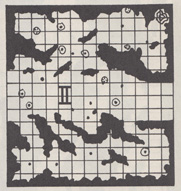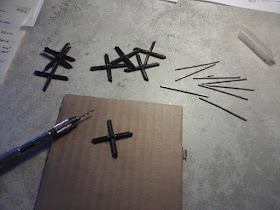The trade ship was rising above the dead planet before the signal lights began their eerie blink and against the creamy cobweb of the great Lens in the sky which was the Galaxy, other black forms rose.
Devers said grimly, "Hold tight, Barr – and let's see if they've got a ship that can match my speed."
He knew they hadn't!...
Devers bent over the little dead globe, watching for a tiny sign of life. The directional control was slowly and thoroughly sieving space with its jabbing tight sheaf of signals.
Barr watched patiently from his seat on the low cot in the corner. He asked, "No more signs of them?"
"The Empire boys? No." The trader growled the words with evident impatience. "We lost the scuppers long ago. Space! With the blind jumps we took through hyperspace, it's lucky we didn't land up in a sun's belly. They couldn't have followed us even if they outranged us, which they didn't."
He sat back and loosened his collar with a jerk. "I don't know what those Empire boys have done here. I think some of the gaps are out of alignment." [Book Two, p. 74-75]
So the first thing that hits me here is how strikingly similar this scene is to the moment in the original Star Wars film when the heroes escape from Mos Eisley spaceport -- the rogue trader odd-coupled with an elderly wise man; a trade ship in hot pursuit by numerous Empire vessels; the trader overwhelmingly confident that his ship is faster; usage of the phrase "jump through hyperspace"; the trader thereafter complaining of malfunctions due to enemy meddling; etc. At the end of this flight the pair will find themselves on the controlling homeworld of the Empire, that being an all-metal planet. In fact, the line about possibly misjumping is almost directly quoted: compare Lathan Devers' "It's lucky we didn't land up in a sun's belly" (above), to Han Solo's "Without precise calculations we could fly right through a star".
Then a few pages later:
Barr stopped, then spoke calmly but with visible restraint. "Look, in the first place, how will you get to the planet Trantor? You don't know its location in space, and I certainly don't remember the co-ordinates, to say nothing of the ephemerae. You don't even know your own position in space."
"You can't get lost in space," grinned Devers. He was at the controls already. "Down we go to the nearest planet, and back we come with complete bearings and the best navigation charts Brodrig's hundred thousand smackers can buy."...
The hypernuclear motor was cut in. The lights flickered and there was the slight internal wrench that marked the shift to hyperspace...
The stars [near the Galactic core] were thick as weeds in an unkempt field, and for the first time, Lathan Devers found the figures to the right of the decimal point of prime importance in calculating the cuts through the hyper-regions. There was a claustrophobic sensation about the necessity for leaps of not more than a light-year. There was a frightening harshness about a sky which glittered unbrokenly in every direction. It was being lost in a sea of radiation. [Book Two, p. 83-85]
So here we see the common trope of a starship pilot anxiously calculating routes for jumps through hyperspace (or whatever you call it). Devers rather callously asserts that "You can't get lost in space", because presumably any nearby planet will be populated and have detailed navigation charts. (This can't be the case in the Star Frontiers campaign setting, because the majority of star systems that one might misjump to are totally unpopulated.) And how much use are those charts? Well, whatever help they provide doesn't entirely negate of the need for labor-intensive per-trip calculations, as we see above (and in other stories, as well). So apparently every interstellar trip needs fresh computations, for some reason -- the details of which I'll leave as an exercise for the reader. What the situation would be like if you didn't have any charts is unknown.
The other thing we see above is one of the relatively few specific references to a specialized drive, here a "hypernuclear motor". That's something which most sci-fi universes presume (including Star Wars), but Doug Niles in Star Frontiers: Knight Hawks went pretty far out of his way to avoid including (for some reason). Now, when things go awry for the Foundation heroes on the Empire's capital, then they have an even narrower escape, along similar lines:
"Can you get away from them?" asked Barr.
Ten ships of the traffic-police wildly followed the runaway craft that had burst out of the lawful, radio-beamed Path of Leaving, and then broken every speed law in creation. Further behind still, sleek vessels of the Secret Service were lifting in pursuit of a carefully described ship manned by two thoroughly identified murderers.
"Watch me," said Devers, and savagely shifted into hyperspace two thousand miles above the surface of Trantor. The shift, so near a planetary mass, meant unconsciousness for Barr and a fearful haze of pain for Devers, but light-years further, space above them was clear...
In grasshopper jumps of increasing magnitude, the trade ship was spanning the Galaxy in its return to the Foundation. [Book Two, p. 93-94]
This is the first-ever mention of yet another potential limitation of the hyperspace Jump mechanic -- namely, that you're not supposed to do it near a large planetary mass. Exactly why this is the case is left unsaid, but clearly it causes a sharp physical change in the experience, resulting in a more dramatic spectacle that the previous established "trifling jar" (link). (See also: "I'd forgotten how much I hate space travel.") Perhaps climbing out of a steep gravity well (as Einstein might put it) increases variation in the calculations to a degree that makes the jump highly unpredictable.
Could this latter limitation have been used by Doug Niles in the Knight Hawks game in place of the rather brittle and contradictory requirement of a certain velocity (1% lightspeed) to enter the Void? I think so, and I think it would be a more satisfying explanation, as well. You'd need to include the notion of dedicated "hyperspace motors", as commonly found in Foundation and most other works of sci-fi, and obviously a faster ship would still be useful in accelerating to the required distance away from a planet. But we could then dispose of the rather silly-on-its-face idea that some special distinguished velocity in a relativistic universe accidentally propels us into interstellar jumps, not have to worry about boardgame ships accidentally triggering this threshold, the rather untenable distinction of "system ships", etc. (as per the original criticism here).
Finally, on the theme of nuclear power whose ever-critical importance underlies the entire Foundation series, here's one of a few cut scenes between the General Bel Riose and the rather less reputable Emperor's Privy Secretary, in this case shortly after capturing the trader Devers' ship:
"I have already sent for clever men who can understand the workings of the odd nuclear field-circuits the ship contains. I have received no answer."
"Men of that type cannot be spared, general. Surely, there must be one man of your vast province who understands nucleics."
"Were there such a one, I would have him heal the limping, invalid motors that power two of my small fleet of ships. Two ships of my meager ten that can not fight a major battle for lack of sufficient power supply. One fifth of my force condemned to the carrion activity of consolidating positions behind the lines." [Book Two, p. 57]
So as the above passage makes clear, the status of the entire Imperial battle fleet is really dependent on whether or not they can find a single person with the knowledge to maintain the (now ancient) "hypernuclear motors" of their capital ships. More on this next time.











